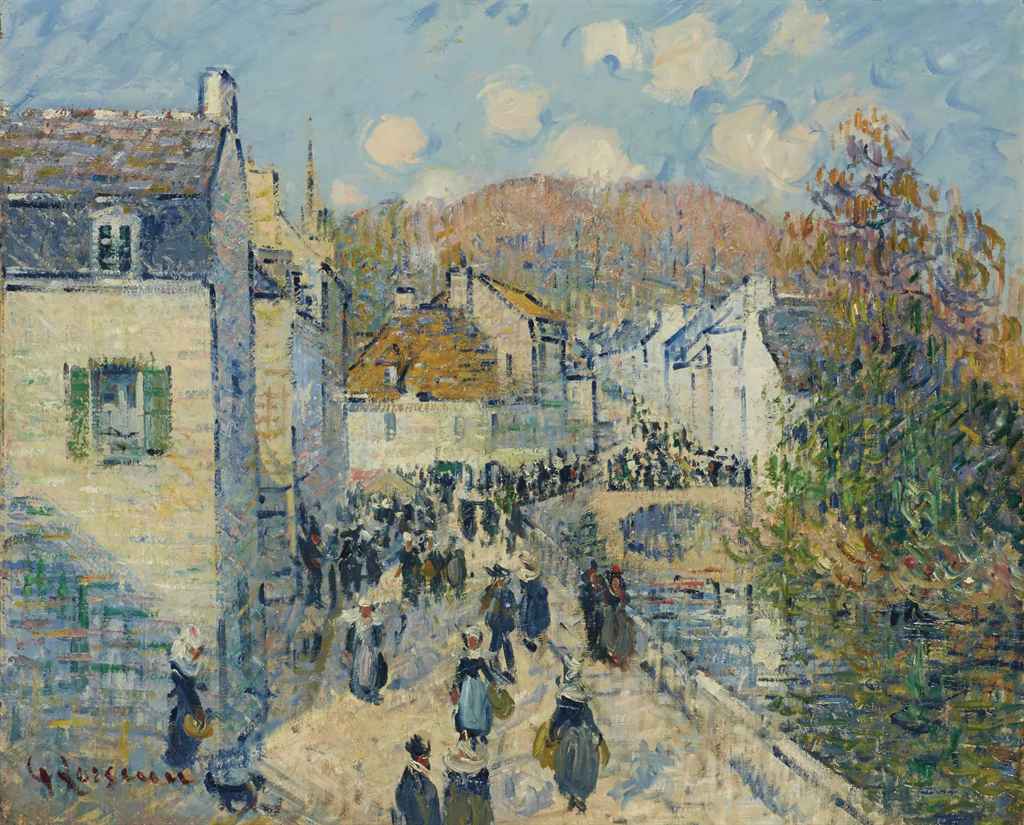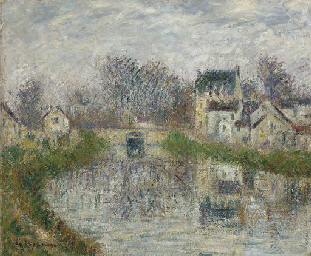Nature morte aux pommes, 1899 Huile sur toile, signée et datée en haut à droite 38 x 55 cm - 15 x 21 1/2 in. Oil on canvas, signed and dated upper right PROVENANCE La Galerie d'Art, Mulhouse et Strasbourg, n°5486 Collection privée, Paris Une simple rencontre suffit à Gustave Loiseau pour se décider à embrasser une carrière artistique à l'âge de vingt-deux ans. C'est en effet après avoir fait la connaissance de Fernand Quignon que Loiseau, alors apprenti charcutier, s'initie à la peinture en suivant les cours de l'Ecole des Arts Décoratifs avant d'intégrer l'atelier de son mentor en 1889. Installé à Pontoise, en région parisienne, l'artiste se rend annuellement à la pension Gloanec, en Bretagne. Il y fréquente Paul Gauguin Emile Bernard, Charles Laval ou encore Paul Sérusier avec qui il formera l'école de Pont-Aven, symbole du vivier artistique regroupé chaque été dans le bourg du même nom. Il expose au Salon des Indépendants en 1893 et participe à trois expositions des peintres impressionnistes et symbolistes de la galerie Le Barc. A partir de 1897, il collabore, à New-York et à Paris, avec le marchand Paul Durand-Ruel, influent promoteur d'artistes impressionnistes et postimpressionnistes. Affilié au second courant, Gustave Loiseau peint de nombreuses scènes de vie agricole et rurale et, dans ses dernières années, de nombreuses natures mortes. A l'image de Cézanne, Gauguin ou encore Renoir, Loiseau choisit ici la pomme comme prétexte à l'étude de la forme et de la composition, la banalité du sujet laissant la place à la technique pour elle-même. L'emphase est mise sur les fruits, auxquels l'alternance de deux couleurs chaudes contribue à donner une vraie rondeur, contrastant avec l'aplat sombre de la table. Par cet arrangement méthodique, Loiseau joue sur les oppositions de tons et de géométrie dans une démarche de recherche sur la perspective qui annonce déjà le XXe siècle. One encounter sufficed for Gustave Loiseau to embrace an artistic career at age 22. Indeed, it was upon meeting Fernand Quignon that Loiseau, an apprentice butcher at the time, learned to paint at the School of Decorative Arts before joining the workshop of his mentor in 1889. Based in Pontoise, in the Paris region, Loiseau went to the Pension Gloanec in Brittany every year. There, he mixed with Paul Gauguin Emile Bernard, Charles Laval and Paul Sérusier with whom he formed the Pont-Aven School, symbolic of the artistic life that took place every summer in the town of the same name. He exhibited at the Salon des Independants in 1893 and participated in three exhibitions of Impressionist and Symbolist painters in the Le Barc Gallery. From 1897, he collaborated with the merchant Paul Durand-Ruel in New York and Paris, an influential promoter of Impressionist and Post-Impressionist artists. Close to the latter movement, Gustave Loiseau painted many scenes of agricultural and rural life and, in his last years, many still lifes. Like Cézanne, Gauguin or Renoir, Loiseau has here chosen the apple as a pretext for the study of form and composition; the subject's banality makes way for technique in its own right. Emphasis is placed on the fruits, to which the two warm colors alternating contribute to the spherical impression, in contrast to the table's dark-colored flatness. Through this methodical arrangement, Loiseau plays on contrasts of hues and geometry in researching matters of perspective, thus already announcing the 20th century.
Nature morte aux pommes, 1899 Huile sur toile, signée et datée en haut à droite 38 x 55 cm - 15 x 21 1/2 in. Oil on canvas, signed and dated upper right PROVENANCE La Galerie d'Art, Mulhouse et Strasbourg, n°5486 Collection privée, Paris Une simple rencontre suffit à Gustave Loiseau pour se décider à embrasser une carrière artistique à l'âge de vingt-deux ans. C'est en effet après avoir fait la connaissance de Fernand Quignon que Loiseau, alors apprenti charcutier, s'initie à la peinture en suivant les cours de l'Ecole des Arts Décoratifs avant d'intégrer l'atelier de son mentor en 1889. Installé à Pontoise, en région parisienne, l'artiste se rend annuellement à la pension Gloanec, en Bretagne. Il y fréquente Paul Gauguin Emile Bernard, Charles Laval ou encore Paul Sérusier avec qui il formera l'école de Pont-Aven, symbole du vivier artistique regroupé chaque été dans le bourg du même nom. Il expose au Salon des Indépendants en 1893 et participe à trois expositions des peintres impressionnistes et symbolistes de la galerie Le Barc. A partir de 1897, il collabore, à New-York et à Paris, avec le marchand Paul Durand-Ruel, influent promoteur d'artistes impressionnistes et postimpressionnistes. Affilié au second courant, Gustave Loiseau peint de nombreuses scènes de vie agricole et rurale et, dans ses dernières années, de nombreuses natures mortes. A l'image de Cézanne, Gauguin ou encore Renoir, Loiseau choisit ici la pomme comme prétexte à l'étude de la forme et de la composition, la banalité du sujet laissant la place à la technique pour elle-même. L'emphase est mise sur les fruits, auxquels l'alternance de deux couleurs chaudes contribue à donner une vraie rondeur, contrastant avec l'aplat sombre de la table. Par cet arrangement méthodique, Loiseau joue sur les oppositions de tons et de géométrie dans une démarche de recherche sur la perspective qui annonce déjà le XXe siècle. One encounter sufficed for Gustave Loiseau to embrace an artistic career at age 22. Indeed, it was upon meeting Fernand Quignon that Loiseau, an apprentice butcher at the time, learned to paint at the School of Decorative Arts before joining the workshop of his mentor in 1889. Based in Pontoise, in the Paris region, Loiseau went to the Pension Gloanec in Brittany every year. There, he mixed with Paul Gauguin Emile Bernard, Charles Laval and Paul Sérusier with whom he formed the Pont-Aven School, symbolic of the artistic life that took place every summer in the town of the same name. He exhibited at the Salon des Independants in 1893 and participated in three exhibitions of Impressionist and Symbolist painters in the Le Barc Gallery. From 1897, he collaborated with the merchant Paul Durand-Ruel in New York and Paris, an influential promoter of Impressionist and Post-Impressionist artists. Close to the latter movement, Gustave Loiseau painted many scenes of agricultural and rural life and, in his last years, many still lifes. Like Cézanne, Gauguin or Renoir, Loiseau has here chosen the apple as a pretext for the study of form and composition; the subject's banality makes way for technique in its own right. Emphasis is placed on the fruits, to which the two warm colors alternating contribute to the spherical impression, in contrast to the table's dark-colored flatness. Through this methodical arrangement, Loiseau plays on contrasts of hues and geometry in researching matters of perspective, thus already announcing the 20th century.

.jpg)

.jpg)
.jpg)
.jpg)
.jpg)
.jpg)
.jpg)

.jpg)
.jpg)

.jpg)
.jpg)
Testen Sie LotSearch und seine Premium-Features 7 Tage - ohne Kosten!
Lassen Sie sich automatisch über neue Objekte in kommenden Auktionen benachrichtigen.
Suchauftrag anlegen